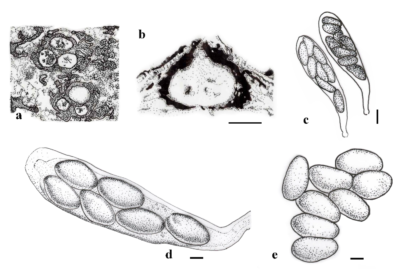Fungalpedia – Note 248, Barriopsis
Barriopsis A.J.L. Phillips, A. Alves & Crous.
Citation when using this entry: Aumentado et al. 2024 (in prep) – Fungalpedia, plant pathogens.
Index Fungorum, Facesoffungi, MycoBank, GenBank, Fig 1.
Classification: Botryosphaeriaceae, Botryosphaeriales, Incertae sedis, Dothideomycetes, Pezizomycotina, Ascomycota, Fungi
Barriopsis was introduced by Phillips et al. (2008), based on morphological characteristics and molecular sequence data. Initially, Barriopsis was classified as Physalospora by Stevens (1926), but it was later transferred to Phaeobotryosphaeria by Petrak & Deighton (1952). Barriopsis considered by Stevens (1926) and Petrak & Deighton (1952) did not have apiculi on its ascospores and were not comparable to Phaeobotryosphaeria, which had small, hyaline apiculi on the ascospores. von Arx & Muller (1954) considered Phaeobotryosphaeria as a synonym of Botryosphaeria. Phillips et al. (2008) initially designated Barriopsis fusca, (N.E. Stevens) A.J.L. Phillips, A. Alves & Crous derived from Physalospora fusca (Stevens 1926), as the type species of Barriopsis. However, this designation was inadvertently invalidated when Botryosphaeria disrupta (Berk. & M.A. Curtis) Arx, & E. Mull. was included as a synonym (Phillips et al. 2013). Hyde et al. (2013) accepted Barriopsis as a genus in Botryosphaeriaceae. Moreover, Wijayawardene et al. (2017) validated the genus Barriopsis and introduced Barriopsis stevensiana A.J.L. Phillips & Pennycook as the new type species, replacing B. fusca.
Barriopsis are characterised by ascomata that are pseudothecial in nature, dispersed or grouped. They range from brown to black and have walls constructed from multiple layers of angular cells. Pseudoparaphyses are hyaline, smooth, have multiple septa, and are constricted. The asci are bitunicate, clavate with a stipe, and are characterised by thick walls with a substantial endotunica and a well-formed apical chamber. The ascospores lack septa and are ellipsoid to ovoid in shape. As they mature, they turn brown and do not possess terminal apiculi (Phillips et al. 2008). The distinguishing feature of the dark brown, aseptate ascospores of B. stevensiana is their clear differentiation from the light brown ascospores of B. disrupta sensu von Arx & Muller (1954). Additionally, ascospores are distinct from hyaline ascospores of Botryosphaeria disrupta (Berkeley 1876).
Barriopsis was established and identified as the sister taxon to Phaeobotryon, utilising molecular sequence data from SSU, ITS, LSU, tef1-α, and tub2 (Phillips et al. 2008). Barriopsis iraniana was introduced by Abdollahzadeh et al. (2009), based on ITS and tef1-α sequence data. Barriopsis tectonae was introduced by Doilom et al. (2014), based on ITS, tub2, and tef1-α sequence data. Barriopsis archontophoenicis was reported by Konta et al. (2016) utilising ITS, LSU, SSU, and tef1-α sequence data. Tibpromma et al. (2017) introduced B. thailandica using ITS and tef1-α sequence data. Five species were accepted based on a combination of morphological and molecular sequence data based on ITS and tef1-α (Jayawardena et al. 2020).
Barriopsis species primarily act as saprophytes and display limited or weak pathogenicity (Phillips et al. 2008, 2013). A pathogenicity test was conducted on Tectona grandis twigs which incited a small lesion (Doilom et al. 2020). While Barriopsis species possess pathogenic potential, their capacity to cause disease is not fully understood, highlighting the need for further research (Abdollahzadeh et al. 2009, Jayawardena et al. 2020). Barriopsis stevensiana and B. iraniana have been isolated from branches, fruits, and leaves exhibiting various disease symptoms, such as dieback, canker, rot, and necrosis (Abdollahzadeh et al. 2009). These symptoms have been observed in plant hosts such as Citrus species, Cupressus sempervirens, Mangifera indica, and Olea species (Abdollahzadeh et al. 2009). Species within this genus might emerge as significant pathogens in the future (Jayawardena et al. 2020).
Type species: Barriopsis stevensiana AJL Phillips & Pennycook
Other accepted species:
- Barriopsis archontophoenicis S. Konta, Boonmee & K.D. Hyde
- Barriopsis iraniana Abdollahz., Zare & A.J.L. Phillips
- Barriopsis tectonae Doilom, L.A. Shuttlew. & K.D. Hyde
- Barriopsis thailandica Dissan., Senan. & K.D. Hyde
Figure 1 – Barriopsis stevensiana. a Ascomata cut through horizontally. b Sections through ascomata. c Mature asci with ascospores. c Ascus with ascospores. d Ascospores. Scale bars: a = 200 μm; c = 20 μm; d, e = 10 μm. Redrawn from Phillips et al. (2008) and Hyde et al. (2020).
References
Berkeley MJ. 1876 – Notices of North American fungi. Grevillea, 4, 105–106.
Petrak F, Deighton FC. 1952 – Beiträge zur Pilzefora von Sierra Leone. Sydowia. 6, 309–322.
Stevens NE. 1926 – Two species of Physalospora on citrus and other hosts. Mycologia, 18(5), 206–17.
Entry by
Herbert Dustin R. Aumentado, Center of Excellence in Fungal Research and School of Science, Mae Fah Luang University, Chiang Rai, Thailand
(Edited by Ruvishika S. Jayawardena, Kevin D. Hyde, Samaneh Chaharmiri-Dokhaharani, & Achala R. Rathnayaka)
Published online 22 April 2024
